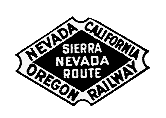Nevada–California–Oregon Railway
 |
|

Original plan for NCO rail network
|
|

NCO station in Reno, Nevada
|
|
| Locale | California, Oregon, and Nevada |
|---|---|
| Dates of operation | 1880–1925 |
| Successor | Southern Pacific Company |
| Track gauge | 3 ft (914 mm) |
| Length | 238 mi (383 km) |
| Headquarters | Reno, Nevada (1880-1918); Alturas, California (1918-1925) |
The Nevada–California–Oregon Railway was a 3 ft (914 mm) narrow gauge railroad originally planned to connect Reno, Nevada, to the Columbia River. However, only 238 mi (383 km) of track were laid so service never extended beyond Lakeview, Oregon. Because of the company’s reputation for mismanagement, it was often called the "Narrow, Crooked & Ornery" railroad.
The railroad was organized in Reno in June 1880 as the Nevada and Oregon Railroad. It was decided that the best plan was to build north to the Columbia River to service cattle ranches and farms in northeastern California and eastern Oregon. The northern terminus was to be The Dalles, Oregon, since that city was located on the Columbia River and had no eastern or southern rail connections at that time.
The company decided to lay 3 ft (914 mm) gauge track because it was cheaper than 4 ft 8 1⁄2 in (1,435 mm) standard gauge construction. Site survey and grading work for the railroad began in December 1880. The first spike was driven in Reno on May 28, 1881. However, the company was short of money so construction was slow. In addition, the board of directors was plagued by corruption and intrigue. One board meeting actually ended with a gun fight between two members. For a period of time, there were two separate boards of directors trying to run the company.
The railroad reached Oneida, California, 30 mi (48 km) north of Reno, on October 2, 1882. Regular service between the two cities began a month later. However, track construction remained slow, and the company’s business problems continued to grow. The Moran Brothers bank in New York was the company’s largest investor. In April 1884, the bank took full control of the railroad, purchasing the company at a court ordered auction for just over $372,000. The company spent the next few years improving existing lines and trying to build up local business.
...
Wikipedia
